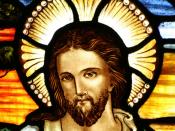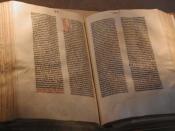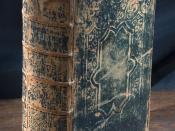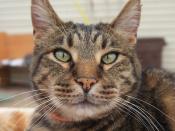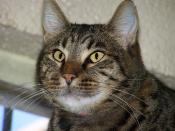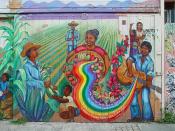Authors often refer to famous or well known stories within their works; these allusions serve to drive their story lines. A built-in allusion to another text can add depth and clarity to a story. In addition, it often runs the story, dictating and predicting an eventual outcome. Throughout both of their works, One Flew Over The Cukoo's Nest by Ken Kessey and The Things They Carried by Tim O'Brian, there are Biblical underlying allusions governing many aspects of both stories.
In his book, Ken Kessey alludes to the Bible several times throughout the story. Specifically, one of his characters, Randle P. McMurphy, shows traits similar to those of Jesus; both are intricate characters that have deeper qualities beyond what they appear to show. McMurphy is said to be "good looking and friendly and everything, but in my humble opinion, he certainly takes over" (Kessey 29). Most of the other characters within the text share this type of first impression of McMurphy that beyond his charming exterior lies a controlling individual inside.
Similarly Jesus was perceived in the same way; at first, he appears to be merely a humble poor carpenter's son. However, another part of Sabatino 2 Jesus emerges, as people soon perceive him as something more than human, a prophet. McMurphy invokes his selflessness and shows his friends how much they mean to him as soon as the opportunity arises. For instance, when his friend George, an obsessive compulsive, has to be cleaned after arriving back from a fishing trip, George is afraid of the hose he is to be cleaned with. He claims it is too dirty to possibly clean him. In response, his good friend Randle, valiantly gets up and tries to protect George, through nonviolent means. Unfortunately, his efforts are unsuccessful and eventually he keeps "walking forward - trudging, flatfooted steps, face down and squinting up between those tattooed fists on each side of his head - till he got the black boy against the ring of nude men and drove a fist square in the center of the white starched chest" (Kessey 230) .
By beating the black aide for George, McMurphy shows that he watches over his friends and attempts to protect them. Similarly, Christ also attempts to care and protect others, specifically by nourishing more than 5000 followers with only 5 loaves of bread and two small fish. Next, after striking out at the Big Nurse, "The Ward Door opened and the black boys wheeled in this gurney with a chart on the bottom that said in heavy letters, McMurphy, Randle P. POST-OPERATIVE. And Sabatino 3 below this was written in ink: LOBOTOMY" (Kessey 269). A lobotomy serves as the final blow to McMurphy's personality and at the same time, a sign to others warding them against taking the road he goes down, a monument triumphing Nurse Ratchet's victory. Christ's most famous sacrifice, being put to death on the cross, can be compared to McMurphy's end; both corpses, parched of all vitality and vigor, stand as beacons guiding others away from inducing a fight with the Big Nurse or the Romans. Even in death, both men still lead the fight against their enemies by becoming martyrs for their causes. Each revitalizes their fight by putting hope in the hearts of the people fighting for their cause, Tim O'Brian's epic struggle is comparable to that of a variety of stories emanating from the Bible. Tim O'Brian is going through a tough time. But, with his personality and eagerness to trust people, he makes it. For instance, O'Brian's platoon meets up with a man called Old Pappa Son. He is a guide and O'Brian takes a liking to him. He develops a relationship with Old Pappa Son based solely on trust. Because Tim has so much trust in this man, his platoon makes it across the merciless mine dotted field. In accordance with the Bible, Christ is also drawn into a fight by obligation of his birthrite; Jesus has the responsibility to spread the word of God, his father. Next, during a patrol, Tim encounters a hostile Vietcong Sabatino 4 soldier and is left with no alternative but to kill him. The very act of taking another man's life weighs heavy upon O'Brian's mind. In fact, it is such a big burden, that the men in his platoon have to keep reassuring him that it is the right thing to do according to the unspoken rules of war. A familiar situation occurs in the Bible; Peter, one of Jesus' apostles, perpetually proclaims his loyalty to Christ in the presence of believers. However, when he confronts non believers, he keeps quiet. As a result, Peter is guilt ridden by his own actions and asks Jesus for forgiveness, sharing similar self loathing feelings as those of O'Brian. Three years after Tim writes a book about his friend Norman Bowker and how he is adjusting to life after the war, Norman hangs himself, apparently out of personal guilt and moral conflict resulting from the war. Reflecting upon this, O'Brian decides to rewrite the book and using Norman's name, shows how heroic Norman's actions really are. By rewriting the book, Tim shows he is compassionate to the memory of his dead friend and wants to keep Norman's favorable image alive in everyone. Similarly, after betraying Jesus to the Romans, Judas is overrun by guilt and moral conflict, so, he takes a rope, throws it over the branch of the Devil tree, and takes his own life out of self repentance. Tim O'Brian shares many experiences with stories of the Bible.
Sabatino 5 O'Brian and McMurphy hold striking comparisons to each other. For instance, both men do for the good of their friends, McMurphy for the other patients, and O'Brian for the men in his platoon. Although it may not seem obvious, both men are actually fighting their own wars. McMurphy's battle is against the Big Nurse and he tries to beat her at every turn. However he is set back in two places. First, he is moved to the Disturbed Ward and receives daily shock treatments; this does not stop him. The next time, he is fired upon by the Big Nurse and does not fare too well. After trying to choke the nurse, McMurphy is given a lobotomy and ultimately loses the fight. O'Brian, on the other hand, is fighting a war against an unseen enemy, the Vietcong. The Vietcong can not be seen unless they attack. Otherwise, they look like everyone else, including the Vietnamese rebel forces. Like McMurphy, O'Brian is shot twice. Also like McMurphy, he bears the first bullet, with second one taking him out of the fight and home. Finally, both men share commonalties with characters found in the Bible. Both O'Brian's The Things They Carried and Kessey's One Flew Over The Cukoo's Nest contain similar underlying Biblical underlying allusions. The main characters in both texts are kind, compassionate men, each fighting an external, Sabatino 6 as well internal battle. Through the use of unwritten allusion to the Bible, both O'Brian and Kessey help to illustrate the goodness in these characters and clarify their conflict in the mind of the reader.
